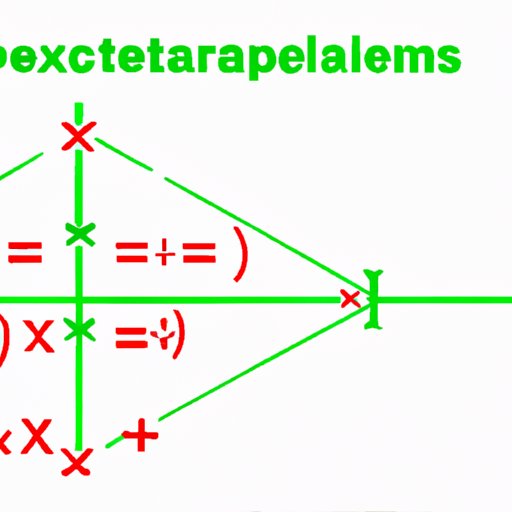I. Introduction
If you’ve ever studied algebra or calculus, you’ve likely come across the concept of X-intercepts. Put simply, X-intercepts are the points where a line or curve intersects the X-axis. While they may seem like a simple concept, knowing how to find X-intercepts is crucial to solving equations and understanding complex functions. In this article, we’ll explore the basics of finding X-intercepts in algebra and move on to advanced techniques using calculus. By the end of this article, you’ll be a master at finding X-intercepts.
II. Mastering the Basics: Simple Tips to Finding X-Intercepts in Algebra
Before diving into advanced techniques, it’s important to master the basics of finding X-intercepts in algebra. X-intercepts are the points on a line or curve where the value of Y is zero. In algebra, a linear equation can be graphed on a coordinate plane, making it easier to identify X-intercepts. To identify the X-intercept of a linear equation, set Y equal to zero and solve for X. This will give you the value of X where the line intersects the X-axis.
III. Visualizing the Solution: Graphical Methods for Finding X-Intercepts
Graphing is a powerful tool for identifying X-intercepts. By graphing a function or equation, you can easily see where it intersects the X-axis. To identify the X-intercept on a graph, look for the point where the curve crosses the X-axis. The slope and Y-intercept of a line can also give you clues to where the X-intercepts are located. A line with a steep slope will intersect the X-axis at a smaller value of X, while a line with a shallow slope will intersect at a larger value of X.
IV. Solving Equations with Ease: Algebraic Methods to Find X-Intercepts
In more complex functions, algebraic methods can be used to solve for X-intercepts. One method is to identify the standard form of an equation, which is Ax+By+C=0. To find the X-intercept, set Y equal to zero and solve for X. Another method is to use the quadratic formula, which is a formula used to solve quadratic equations. By setting the equation equal to zero and plugging in the coefficients into the formula, you can solve for the X-intercepts.
V. The Importance of Understanding X-Intercepts in Real-Life Situations
X-intercepts have practical applications in everyday life. For example, a business can use X-intercepts to determine when they will break even or make a profit. In science, X-intercepts can be used to predict changes in quantities over time. Understanding X-intercepts is also important for understanding functions and systems, such as in economics or engineering.
VI. Common Mistakes and How to Avoid Them When Finding X-Intercepts
Even the most seasoned mathematicians can make mistakes when finding X-intercepts. One common error is forgetting to set Y equal to zero when finding the X-intercept in an equation. Another mistake is misinterpreting the meaning of the slope, Y-intercept, or X-intercept. To avoid these mistakes, it’s important to carefully read and analyze the problem before jumping into a solution. Double-check your work and make sure your answer makes sense in the context of the problem.
VII. Step-by-Step Guide: How to Quickly Find X-Intercepts on a Graph
Using a step-by-step guide can make finding X-intercepts on a graph quick and easy. Start by graphing the function or equation on a coordinate plane. Next, identify where the curve intersects the X-axis. Set Y equal to zero and solve for X to find the X-intercept. Repeat this process for all X-intercepts on the graph. Real-life examples can help to solidify your understanding of this process and give you confidence in your ability to identify X-intercepts.
VIII. Advanced Techniques: Using Calculus to Find X-Intercepts of Complex Functions
For more complex functions, calculus provides powerful tools for finding X-intercepts. By finding the derivative of the function, you can find the slope of the curve at any point. The X-intercept will occur where the slope is zero, so by setting the derivative equal to zero and solving for X, you can find the X-intercept. Calculus can also be used to find the X-intercept of a function with multiple variables. While this technique is more advanced, it can provide a more in-depth understanding of complex functions.
IX. Conclusion
Whether you’re a student learning algebra for the first time or a seasoned mathematician, knowing how to find X-intercepts is a crucial skill. From mastering the basics to using advanced techniques, this article has provided comprehensive coverage on finding X-intercepts in algebra. Remember to carefully analyze the problem, use visualization techniques, and double-check your work to avoid common mistakes. With practice and patience, you’ll be able to quickly and confidently identify X-intercepts in any problem.
If you have any questions or queries on anything not covered in this article, we invite you to ask us in the comments below.
